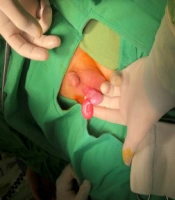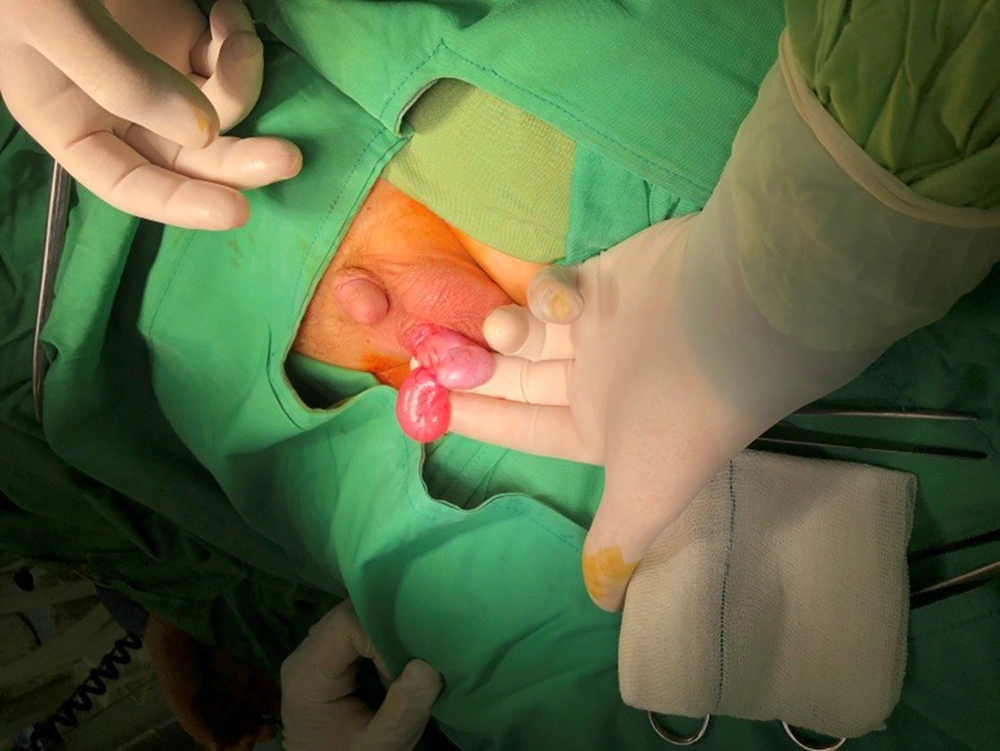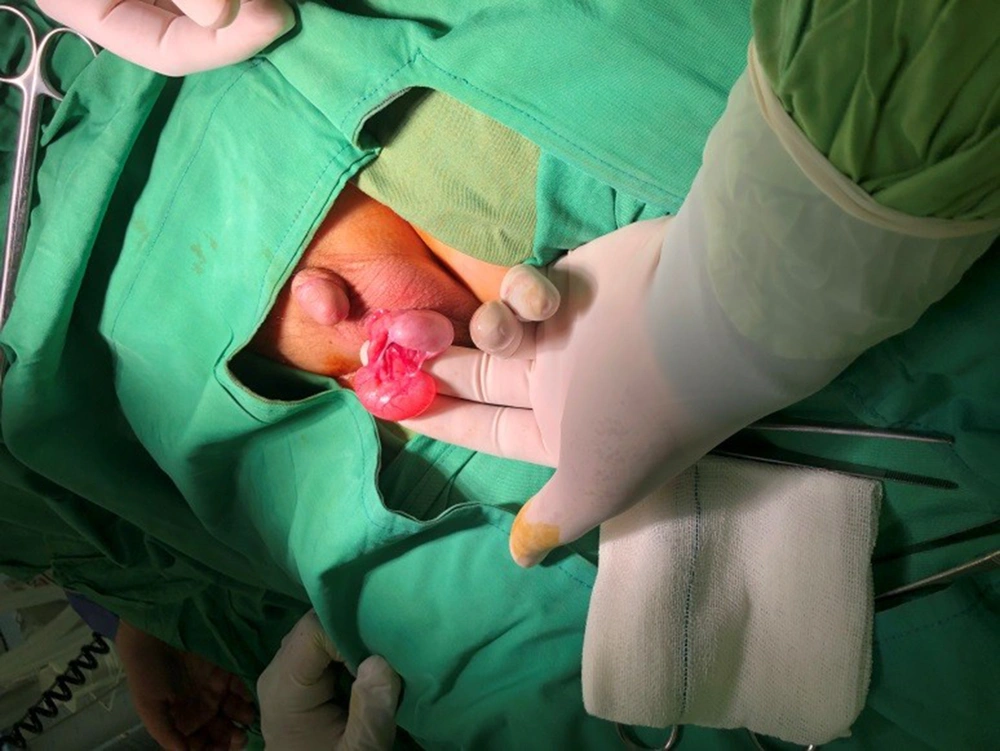1. Introduction
In general surgery, the acute scrotum is equivalent to the acute abdomen. The acute scrotum is caused by torsion of the testicular appendix or testis, trauma, inflammation, infections, and hemorrhage or infection as acute events in chronic disease, which superimpose on hydrocele, varicocele, spermatocele, and testicular tumor. Suspected testicular torsion requires immediate exploration to rescue the affected testis within the duration of the ‘golden time’ (1, 2). In some cases, testicular torsion diagnosis as the most sensitive differential diagnosis cannot be easy, even using Doppler ultrasonography (US) (3).
Spermatic cord cysts or hydrocele may cause scrotal aching rarely with confusing diagnosis. It can evoke long-term scrotal pain due to its acute setting, which is an uncommon differential diagnosis for acute scrotum. Torsion of spermatic cord cyst or hydrocele has been reported three times in English literature (4, 5). Here, we showed a rare case of a twisted spermatic cord cyst or hydrocele suspected of testis torsion.
2. Case Presentation
A boy aged 14 was referred to the emergency clinic of Imam Reza Hospital, Ardabil, suffering from acute scrotal pain without specific radiation, which lasted for six hours and was accompanied by vomiting and nausea without fever.
On physical examination, he had a good general condition, and except scrotum, other organs were normal. The left hemiscrotum (a1) was tender and high riding. The left testis and epididymis were not distinguishable. There was no sign of skin purpura or scrotal edema. The patient had no history of testicular abnormalities. His medical history was non-remarkable, with no history of inguinal or scrotal discomfort or genetic disease.
Testicular torsion doubted with absent left testicular cremasteric reflex and Prehn sign. CBC and U/A were normal. Testis Doppler US was performed to confirm the suspicion of displaying decreased left testis perfusion with normal echogenicity. CBC, U/A, and Doppler US results were so expeditious that they were ready until operating room staff became available. Because of diagnostic dilemma in physical examination, Doppler US was performed reporting decreased testicular perfusion without any cyst (Table 1).
| CBC | U/A | Cremastric Reflex/Prehn Sign | Ultrasonography | Nausea/Vomiting |
|---|---|---|---|---|
| WBC: 5700; Hb: 13.9 | WBC: 2-3; RBC:1-2 | Absent | Decreased testis perfusion | Present |
Case Presentation Summary
2.1. Therapeutic Intervention
Left scrotal exploration was performed under spinal analgesia. Contrary to what was expected, the testis had good color with no sign of ischemia; however, it was evident that a spermatic cord cyst twisted around the testis with intact epididymis without testicular perfusion impairment (Figure 1). The pink cyst (a1) adhered to the spermatic cord and separated from the epididymis was subsequently untwisted from around the testis and marsupialized (Figure 2). Cyst content was clear and non-hemorrhagic, and non-ischemic. We performed bilateral orchiopexy, although there was no testicular torsion.
2.2. Follow-up and Outcomes
Analgesics (supp acetaminophen 120 mg every night) and antibiotics (syr cephalexin 250 mg 5 cc every 6 hours) were commenced, and the patient was discharged the next day. In a 3-month follow-up, the testis and spermatic cord did not show any abnormalities or unexpected events.
3. Discussion
In an emergency setting, spermatic cord cysts or hydroceles are so rare findings, while scrotal swelling could mean a horrifying diagnosis, such as testis torsion or strangulated inguinal hernia. Ultrasonography and Doppler revealing decreased testicular flow incensed us to immediate exploration. Scrotal incision and testis assessment revealed healthy testis and epididymis with twisted spermatic cord cysts around them. Spermatic cord cysts might be simple or multilocular, contain sedimental (a1) debris, and can bring about long-term scrotal pain. They are benign and can be isolated from cystadenoma or epididymal head cysts (1, 5).
On palpation, spermatic cord cysts are tense with elasticity, adjoined to the cord, and resting apart from the testis and epididymis. It is possible to detect it by ultrasonography, although spermatic cord cyst may cause diagnostic problem in acute scrotal cases (4). Incomplete occlusion of peritoneal processus vaginalis (a2) or coelomic epithelium remnants could be named as factors that can give rise to this condition (6).
Here we present a case of a 14-year-old boy visiting the clinic suffering from acute scrotal pain with high riding testis as well as decreased testicular perfusion evidenced by Doppler US, which all warranted immediate scrotal exploration. Thus, torsion of the spermatic cord cyst was not among our differential diagnoses. Exploration revealed that the cyst twisted around the testis, lacking any sign of ischemia. The epididymal cyst is part of the epididymis, while the spermatic cord cyst is completely separated from the epididymis and adheres to the spermatic cord (5). Subsequently, the cyst was marsupialized, and serum liquid was evacuated. This finding is especially rare. No similar cases were discovered in the literature review, and ours can be the first reported spermatic cord cyst torsion case. Clinical symptoms and acute pain, along with Doppler US, indicated incomplete torsion, but exploration could determine that neither testis nor epididymal cyst torsion was the source (2, 3, 6). Management of the torsion to the spermatic cord cyst could be conservative with analgesics and anti-inflammatory treatment if it were to be confirmed with absolute certainty. However, clinical assessment and sonography could not differentiate spermatic cord cyst torsion from testicular torsion clearly. Because cyst torsion has not harmed testis perfusion, provided diagnosis, it might be managed conservatively. Whenever testicular torsion diagnosis preoperatively is not determined by physical examination and Doppler US, a clinician might doubt spermatic cord torsion, although exploration is obligatory in testicular torsion skepticism. Hence, Spermatic cord cyst torsion seems to be a source of confusion, requiring further research to improve the precision of diagnoses.
3.1. Conclusions
A spermatic cord cyst or hydrocele torsion is a rare cause of acute scrotum with a good prognosis. However, every suspicion must be confirmed by scrotal exploration.
3.2. Patient Perspective
I had severe testicle pain that was relieved after surgery. Following 3-month, I am good without any problems. We will be glad if our case is published.


